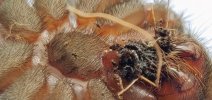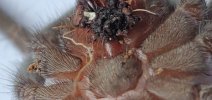neogold
New Member
- Messages
- 10
- Location
- Netherlands
Hi all,
I'm in the tarantula hobby for over a year now (NW only, about 15 T's). One of my latest additions was a Xenesthis Immanis (DLS around 8 cm). I only had for a bit more than a month. It ate quite well in the first weeks or so (crickets) and then stopped eating. So, I was actually awaiting a (pre) molt. 2 days ago I saw it in the corner of it's enclosure lying basically on it's side between the cork bark and the corner.
Clearly this was no molt so I removed the cork bark and it remained where it was but was sluggsihly moving - not looking healthy from its movements (have seen molts before).
I decided to wait just in case I was wrong - although the soil (coco fiber with peat, a little vermiculite and sphagnum) was not dry and certainly not wet - made the ground around the T a little more wet.
To make a long story short - the T did not improve. It moved slowly and slumped on the cork bark (placed back in the enclosure ) with legs not (yet) in a death curl but much more bent than normal.
Yesterday I left it to itself but at the end of the day it looked to be in a death curl - although it moved in sloooow motion when touched with a pencil.
This morning it was dead. I looked with the phone camera whether something was clearly amiss. On the whole it actually looked good - shining abdomen, not too fat (imo).
The only thing which looked odd was the stuff around it's mouth (not looking very clean anyway). There appear to stick small straws of something (coco fiber ? something of the T itself? ) out of it's mouth (last 2 pictures).
Anyone who has experience can hopefully comment on this? . I would hate to see more of the T's die (certainly if it can be prevented)
I'm in the tarantula hobby for over a year now (NW only, about 15 T's). One of my latest additions was a Xenesthis Immanis (DLS around 8 cm). I only had for a bit more than a month. It ate quite well in the first weeks or so (crickets) and then stopped eating. So, I was actually awaiting a (pre) molt. 2 days ago I saw it in the corner of it's enclosure lying basically on it's side between the cork bark and the corner.
Clearly this was no molt so I removed the cork bark and it remained where it was but was sluggsihly moving - not looking healthy from its movements (have seen molts before).
I decided to wait just in case I was wrong - although the soil (coco fiber with peat, a little vermiculite and sphagnum) was not dry and certainly not wet - made the ground around the T a little more wet.
To make a long story short - the T did not improve. It moved slowly and slumped on the cork bark (placed back in the enclosure ) with legs not (yet) in a death curl but much more bent than normal.
Yesterday I left it to itself but at the end of the day it looked to be in a death curl - although it moved in sloooow motion when touched with a pencil.
This morning it was dead. I looked with the phone camera whether something was clearly amiss. On the whole it actually looked good - shining abdomen, not too fat (imo).
The only thing which looked odd was the stuff around it's mouth (not looking very clean anyway). There appear to stick small straws of something (coco fiber ? something of the T itself? ) out of it's mouth (last 2 pictures).
Anyone who has experience can hopefully comment on this? . I would hate to see more of the T's die (certainly if it can be prevented)



